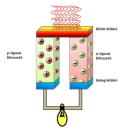




Investigation of the redox transformations of conducting polymers via in situ, simultaneous combined techniques .
Our research group developed in situ combined techniques (spectroelectrochemistry,
simultaneous combined techniques .
Our research group developed in situ combined techniques (spectroelectrochemistry, electrochemical quartz crystal nanobalance, conductivity measurement) to monitor redox alterations
electrochemical quartz crystal nanobalance, conductivity measurement) to monitor redox alterations in conducting polymers. Most recently a novel hyphenated combined in situ method was
in conducting polymers. Most recently a novel hyphenated combined in situ method was established, which involves the parallel monitoring of UV-Vis spectra and electrical conductivity. For
established, which involves the parallel monitoring of UV-Vis spectra and electrical conductivity. For these complex experiments special electrodes are needed, therefore a novel cell-configurations
these complex experiments special electrodes are needed, therefore a novel cell-configurations were also developed.
Synthesis and characterization of ferrit-containing conducting polymer nanocomposites
were also developed.
Synthesis and characterization of ferrit-containing conducting polymer nanocomposites  Synthesis and characterization of conducting polymer composites containing magnetic
Synthesis and characterization of conducting polymer composites containing magnetic nanoparticles attract increasing attention, nowadays. Magnetic nanoparticles (e.g. Fe2O3, Fe3O4,
nanoparticles attract increasing attention, nowadays. Magnetic nanoparticles (e.g. Fe2O3, Fe3O4, CoFe2O4, Ni, Fe, metal alloys) with typical size of 1-30 nm usually exhibit superparamagnetic
CoFe2O4, Ni, Fe, metal alloys) with typical size of 1-30 nm usually exhibit superparamagnetic features, but rarely ferri- or ferromagnetic properties can also be observed. Incorporation of these
features, but rarely ferri- or ferromagnetic properties can also be observed. Incorporation of these nanoparticles results in hybrid materials which can be used in many different fields, e.g., magnetic
nanoparticles results in hybrid materials which can be used in many different fields, e.g., magnetic separation, microwave shielding, catalysis, and sensors.
Photoactive hybrid organic/inorganic assemblies based on conducting polymers
separation, microwave shielding, catalysis, and sensors.
Photoactive hybrid organic/inorganic assemblies based on conducting polymers Hybrid materials based on conducting polymers (CPs) and inorganic semiconductors (SCs)
Hybrid materials based on conducting polymers (CPs) and inorganic semiconductors (SCs) undoubtedly constitute one of the most promising classes of new materials. Beyond scientific and
undoubtedly constitute one of the most promising classes of new materials. Beyond scientific and fundamental interest, such hybrid assemblies are attractive from technological perspectives as well,
fundamental interest, such hybrid assemblies are attractive from technological perspectives as well, for example, in energy conversion & storage, electronics, catalysis, and optics. CPs can be
for example, in energy conversion & storage, electronics, catalysis, and optics. CPs can be employed both as sensitizers and hole-transporters in such applications. In this vein we assemble
employed both as sensitizers and hole-transporters in such applications. In this vein we assemble organized nanoarchitectures of CPs and oxide SCs.
Conducting polymer-based hybrid materials with thermoelectric properties
organized nanoarchitectures of CPs and oxide SCs.
Conducting polymer-based hybrid materials with thermoelectric properties Conducting polymers have prominently large Seebeck-coefficient - some cases it can even exceed
Conducting polymers have prominently large Seebeck-coefficient - some cases it can even exceed 1mV/K, which is five times larger than that of bismuth telluride (Bi2Te3), the most frequently used
1mV/K, which is five times larger than that of bismuth telluride (Bi2Te3), the most frequently used inorganic thermoelectric material. This fact makes CPs attractive candidates for fabricating new
inorganic thermoelectric material. This fact makes CPs attractive candidates for fabricating new generation lightweight and flexible thermoelectric materials. In addition, polymers generally have
generation lightweight and flexible thermoelectric materials. In addition, polymers generally have low thermal conductivity () which is also an important factor in the high thermoelectric figure of
low thermal conductivity () which is also an important factor in the high thermoelectric figure of merit.
merit.
 simultaneous combined techniques .
Our research group developed in situ combined techniques (spectroelectrochemistry,
simultaneous combined techniques .
Our research group developed in situ combined techniques (spectroelectrochemistry, electrochemical quartz crystal nanobalance, conductivity measurement) to monitor redox alterations
electrochemical quartz crystal nanobalance, conductivity measurement) to monitor redox alterations in conducting polymers. Most recently a novel hyphenated combined in situ method was
in conducting polymers. Most recently a novel hyphenated combined in situ method was established, which involves the parallel monitoring of UV-Vis spectra and electrical conductivity. For
established, which involves the parallel monitoring of UV-Vis spectra and electrical conductivity. For these complex experiments special electrodes are needed, therefore a novel cell-configurations
these complex experiments special electrodes are needed, therefore a novel cell-configurations were also developed.
Synthesis and characterization of ferrit-containing conducting polymer nanocomposites
were also developed.
Synthesis and characterization of ferrit-containing conducting polymer nanocomposites  Synthesis and characterization of conducting polymer composites containing magnetic
Synthesis and characterization of conducting polymer composites containing magnetic nanoparticles attract increasing attention, nowadays. Magnetic nanoparticles (e.g. Fe2O3, Fe3O4,
nanoparticles attract increasing attention, nowadays. Magnetic nanoparticles (e.g. Fe2O3, Fe3O4, CoFe2O4, Ni, Fe, metal alloys) with typical size of 1-30 nm usually exhibit superparamagnetic
CoFe2O4, Ni, Fe, metal alloys) with typical size of 1-30 nm usually exhibit superparamagnetic features, but rarely ferri- or ferromagnetic properties can also be observed. Incorporation of these
features, but rarely ferri- or ferromagnetic properties can also be observed. Incorporation of these nanoparticles results in hybrid materials which can be used in many different fields, e.g., magnetic
nanoparticles results in hybrid materials which can be used in many different fields, e.g., magnetic separation, microwave shielding, catalysis, and sensors.
Photoactive hybrid organic/inorganic assemblies based on conducting polymers
separation, microwave shielding, catalysis, and sensors.
Photoactive hybrid organic/inorganic assemblies based on conducting polymers Hybrid materials based on conducting polymers (CPs) and inorganic semiconductors (SCs)
Hybrid materials based on conducting polymers (CPs) and inorganic semiconductors (SCs) undoubtedly constitute one of the most promising classes of new materials. Beyond scientific and
undoubtedly constitute one of the most promising classes of new materials. Beyond scientific and fundamental interest, such hybrid assemblies are attractive from technological perspectives as well,
fundamental interest, such hybrid assemblies are attractive from technological perspectives as well, for example, in energy conversion & storage, electronics, catalysis, and optics. CPs can be
for example, in energy conversion & storage, electronics, catalysis, and optics. CPs can be employed both as sensitizers and hole-transporters in such applications. In this vein we assemble
employed both as sensitizers and hole-transporters in such applications. In this vein we assemble organized nanoarchitectures of CPs and oxide SCs.
Conducting polymer-based hybrid materials with thermoelectric properties
organized nanoarchitectures of CPs and oxide SCs.
Conducting polymer-based hybrid materials with thermoelectric properties Conducting polymers have prominently large Seebeck-coefficient - some cases it can even exceed
Conducting polymers have prominently large Seebeck-coefficient - some cases it can even exceed 1mV/K, which is five times larger than that of bismuth telluride (Bi2Te3), the most frequently used
1mV/K, which is five times larger than that of bismuth telluride (Bi2Te3), the most frequently used inorganic thermoelectric material. This fact makes CPs attractive candidates for fabricating new
inorganic thermoelectric material. This fact makes CPs attractive candidates for fabricating new generation lightweight and flexible thermoelectric materials. In addition, polymers generally have
generation lightweight and flexible thermoelectric materials. In addition, polymers generally have low thermal conductivity () which is also an important factor in the high thermoelectric figure of
low thermal conductivity () which is also an important factor in the high thermoelectric figure of merit.
merit.




























